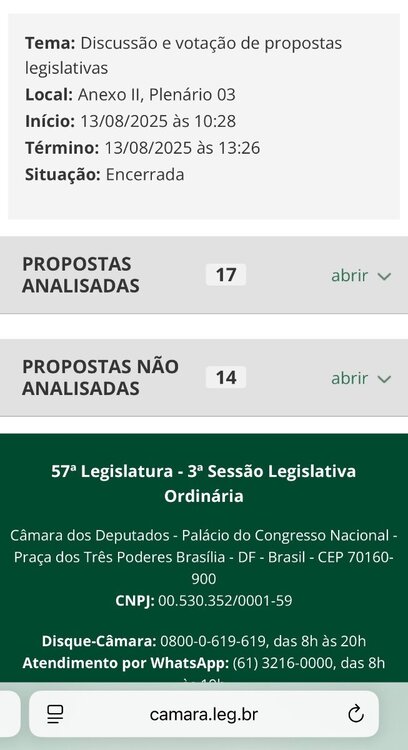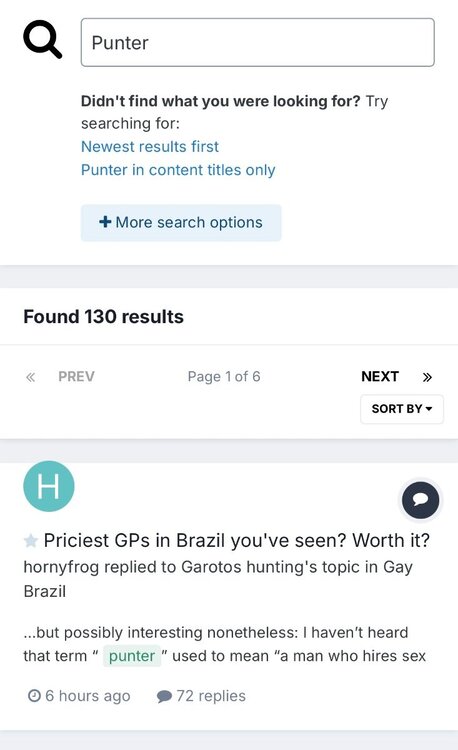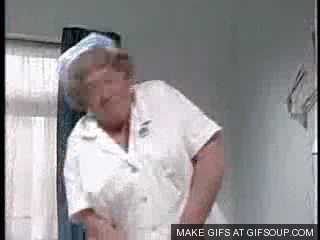
Riobard
Members-
Posts
4,588 -
Joined
-
Last visited
-
Days Won
19
Content Type
Profiles
Forums
Events
Everything posted by Riobard
-
They made it through 17 of 31 agenda items and this topic was not (or not yet) covered. I’m as bored about it as I’m bored about board trolls. I extensively contribute to the tourism economy either way. My only interest is in expanding migratory period 90 day limit without the hassle of imploring fed police for extensions not guaranteed. Prospective visa application candidates? Have at it. Better yet, just apply and get one.
-
Priciest GPs in Brazil you've seen? Worth it?
Riobard replied to Garotos hunting's topic in Gay Brazil
No babes. Not at all. It takes a mean dullard. I was referring to your owning being off topic. Off topic on the Brazil subforum is anything not $$$. It just read as funny because nonfinancial posts such as label discussions are, thus, waaaaaaay off the page🤣 I just can’t bring myself to offer the title “client” to some here. Punter generically works. But you piqued my interest and here’s the search yield here, waaaaaay off topic. -
Priciest GPs in Brazil you've seen? Worth it?
Riobard replied to Garotos hunting's topic in Gay Brazil
Slightly? I use the term frequently but perhaps its reduced presence is due to my regular employment of the term "cheapo" because, you know, trolls with 0 fan base and cheapos ... birds of a feather flock and fuck over poor local trade together. -
Thanks. You are one of the many good ones. I do follow the news on this. I enter by searching “camara dos deputados agenda” and search under today’s date for Defense and Foreign Affairs where PDL 206/2023 is centred. It is listed today under propositions and votes, along with related documents and the trajectory from March. The opinions are one-sided, for the proposition, and do not much allude to the conflicts about which I am already aware. But Van Hattem’s brief is interesting. I’m not surprised about the complexity and bureaucratic layers and that a subcommittee or individual ministry would be reviewing it and perhaps need to endorse it preparatory to sending it up the line for a truly representative house vote. The two opposing political perspectives cancelling each other out certainly explain the inertia regarding any impending alterations to the visa requirements. I have no skin in the game as I have the visa. If it’s reversed I suppose some here may be interested if it obviates the need to apply. I expect if it’s reversed it will become common knowledge but my breath is not bated waiting. Apologies for deviating from the obsessional topics of trade fees. I would also be fine with my perspectives on the e-visa and CPF application topics being redacted. I can access the resources that truly matter to me in Brazil without chiming in on the minutiae of travel planning, and the usual array of board trolls don’t impede such accessibility and enjoyment. They just shed light on what the acompanhantes are up against and this amplifies my awe and respect for commercial sex workers.
-
Need an emoji conveying Ignoraflorabot notification received. it's writing for 2, so somebody else oil it.
-
-
Don't just talk to your meds dosette, Pete rrs. Take them.
-
Morning ablutions? No need to look in the mirror every day and flog self with razor strap. Be kind to yourself.
-
More importantly, relate to.
-
Encryption: Got that, village boys? Keep up the tiresome good work of avoiding stand underlurkers digging in at their post.
-
-
Priciest GPs in Brazil you've seen? Worth it?
Riobard replied to Garotos hunting's topic in Gay Brazil
Can’t see, but the assumed rational take is Lady Floribot not serially killing it here with fleabite-grade unzingers. Leapbot best strategy. -
Difficult to assess merit of ignored florid bot content. May be breakthrough sanity, nevertheless of little worth. Bot unlikely capable of influencing ignore preferences. Ignore is default for need to snooze malfunctioning bot pending repair. Recycle rinse repeat. 🤷🏼
-
Priciest GPs in Brazil you've seen? Worth it?
Riobard replied to Garotos hunting's topic in Gay Brazil
They do have good instincts. I saw one, barely legal looking mind you and much younger than my preferred type, pairing off in São Paulo with a scary looking punter, one that scared the bejeesus out of me upon intersecting, but that only looks like a serial killer and has the virility of a snowflake. -
Because it’s not Florida and he knows Florida is always where you don’t want it to be, but he also may realize that Florida in Mexico is where you don’t want it to be, so wants to know the geo stats. Bot-um line; Florida is unavoidable anywhere. Mexico is a pipe dream containing a Florida nightmare. He may as well lispingly kiss ambrosia and be a bit better off but not by much.
-
Maybe he even makes you look good.
-
Do you view escort hires as "sanitary" experiences?
Riobard replied to unicorn's topic in The Beer Bar
-
Priciest GPs in Brazil you've seen? Worth it?
Riobard replied to Garotos hunting's topic in Gay Brazil
I travel on a research grant and engage in related chat to track over time the deteriorating condition of a deeply unique Floridian troll-bot that is banned from my home base. Also to alert the team when its keyboard requires replacement, which is as you can imagine, a lot. I understand there was a major short circuit as illustrated by a long string of numbers related to, of all things, a finances topic. Keyboard on order. Whenever, I try to Ignore it the contract gets renewed. The central investigative agenda is why it even needs to hire at all, while proclaiming high level expertise and finesse in doing so. Oh … Don't be sad. It's non-sentient and its fear of Gremlins is overblown. -
Bangu Shopping is near by and fairly upscale, as well as a hospital, so I think drivers that seek requests within the area must be accustomed. Commuter train from Central to Bangu Station is a good and safe option for the major part of the trek and that station is very close to the aforementioned retail centre. But that’s a huge rail haul from Copanema and further west. The main issue is that the proximity to the club at that point may create the illusion that a very short jaunt on foot for that last stretch is without hazard. Take a look at Streetview and Earth to get the flavour. But there are ride platform hail options to manage that leg and the vehicle route is surprisingly circuitous so the fare gets a bit stretched out. Agree with Xclay timing. Do your Sunday tarde worship best in your Sunday best and take in a scheduled evening mass and confession afterwards back near your lodgings. Watch out for the boatches.
-
Priciest GPs in Brazil you've seen? Worth it?
Riobard replied to Garotos hunting's topic in Gay Brazil
What is key is whether they can grasp what off-the-charts proficiency is required to get me out of my shorts. -
Chamber of Deputies votes tomorrow whether to throw in with the Senate to revoke recent visa reinstatement. Tentative opinion is that the proposition will pass.
-
Priciest GPs in Brazil you've seen? Worth it?
Riobard replied to Garotos hunting's topic in Gay Brazil
Don’t try reasoning with a bot. One recent 117 quiet night there were a few escorts seemingly waiting at the stairs landing to be called up in sequence. The punter was evidently from a nation in which the Med Sea touches its coast. As this seemed unusual I asked one of the escorts not in queue what that was all about. He said it was a rich client. I had to chuckle; it likely cost the equivalent of a few drinks and a brief private dance at strip club night in Canada. -
That comment tracks. Look at the lips, realize that her imaginary mirror is not there for the sake of safety. You are channeling Chicago nurse, Ratchett trained, badgering psychologically integrated persons on this board on top of harassment of amputees on the CTA to your imaginary shift work at your appropriately padded post?
-
Priciest GPs in Brazil you've seen? Worth it?
Riobard replied to Garotos hunting's topic in Gay Brazil














